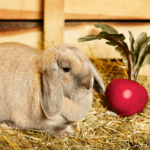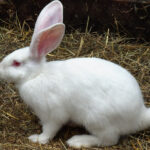If your rabbit is having trouble eliminating, urine will sink into their fur. As the urethra of a rabbit is located at their hindquarters, this will often lead to a wet tail.
It doesn’t stop here, though. Urine will dribble down a rabbit’s hind legs, and stain their fur yellow. This isn’t just unsightly and potentially smelly. It’s hazardous to a rabbit’s health.
Urine scald causes a rabbit’s fur to fall out. It also leaves a bunny’s skin sore. Eventually, this skin will break and leave your rabbit open to infection. The most significant risk here is Flystrike, which is a fatal condition for rabbits.
Wet tail and urine scalding are symptoms of a wider problem. Just washing your rabbit is not sufficient treatment. You’ll need to get to the root of the issue and resolve it.
What Are the Symptoms of Wet Tail in Rabbits?
Depending on how severe the urine scalding is, your rabbit’s tail will be damp or soaking wet. Neither of these conditions is healthy for a bunny to live with. They should be dry at all times.
There are many ways that urine scald impacts your rabbit. Symptoms include:
- Clear and visible urine stains on the hind legs
- A strong smell of ammonia following your rabbit
- Bald patches and missing fur around the back legs
- Red skin and open wounds down the rear legs
- Whimpering, squealing and other vocalizations of pain while urinating
- Loss of appetite
If you spot any of these issues, you’ll need to take action. Your bunny is uncomfortable and in danger of severe health complications.
What Are the Causes of Wet Tail in Rabbits?
It’s important to remember that your rabbit having urine scald doesn’t necessarily mean you’re neglecting your rabbit, Urine scald can be something that is missed by owners as your rabbit can hide pain fairly well.
Arthritis
Osteoarthritis, commonly referred to as arthritis is an extremely painful joint disease that impacts a lot of creatures, including ourselves. Due to the shape of a rabbit, Arthritis can make grooming often difficult and painful.
This disease will impact your rabbit’s hips and leg joints making twisting extremely difficult and as a result, making it hard for your rabbit to wash properly.
Whilst Arthritis cannot be cured, it can be managed via medication and lifestyle changes.
Bladder Stones / Bladder Infection
Urinary issues can be a key cause of urine scalding, including urinary tract infections, Bladder stones, Bladder sludge & uterine cancer.
Unfortunately, they all have their own symptoms and problems which we go into further detail in their own posts.
If you have female rabbits, we highly recommend getting them spayed as this lowers the risk of developing uterine cancer significantly.
Dehydration
This may sound backward, but dehydration can lead to a UTI which results in urine scalding.
This is why it is crucial that your rabbit is constantly hydrated, if you’re unsure, check the bunny’s urine.
Brown urine typically means they are dehydrated and need some water or fresh greens.
Diarrhea
If your rabbit is having issues with their feces, they may have a dirty bottom which can result in urine scalding as they develop matted fur.
Over time, you may find your rabbit has hair loss due to the urine scald and poo which will burn at their skin leading to infections.
If your rabbit has diarrhea, we highly recommend reaching out to a veterinarian as this may be due to a gut infection, parasite, tumor, or dental disease.
Dirty environment
To avoid potential skin conditions & infections, we recommend cleaning your rabbit’s environment every few days, this is because wet bedding and toilets can be a home for flies and varying other bacteria that may speed up infections and urine scald.
If your rabbit’s enclosure is dirty, or cluttered, they will likely not want to clean themselves.
Obesity
Rabbit obesity is something that occurs in many households and occurs when your rabbit’s diet isn’t regulated.
A healthy weight is something that can be easily resolved by encouraging exercise as well as a dietary change.
If your rabbit is obese, we recommend visiting a local veterinarian who can help create a strict diet plan to assist with healthy levels of weight loss.
You should never change your rabbit’s diet drastically as they will need slowly changing.
Why Does Wet Tail Need to be Treated?
Sometimes, there will be little that you can do to prevent urine scald. In the case of hind leg paralysis, your rabbit will always have difficulty avoiding it. You can take lifestyle steps to minimize the risk, though.
It must also be noted that just cleaning up your rabbit’s urine scald is not enough. Your rabbit has a problem that must be resolved. Failing to do so can lead to a range of health concerns. Also, constant urine scald is painful.
Urine scald must never be ignored. The longer the issue continues, the more likely a rabbit is to develop Flystrike. This is a potentially fatal disease in rabbits.
How Can Wet Tail in Rabbits be Prevented?
No treatment is preferable to preventing urine scalding in the first place. Do whatever you can to keep them ailments at bay.
Many rabbits past middle age will struggle with urine scald at one time or another, though. Take steps to delay the inevitable. These include:
- An appropriate hutch. If your rabbit’s hutch is too small, the risk of a Wet Tail is magnified. Your bunny needs space to move.
- Litter training. If you litter train your rabbit, they’ll keep their eliminations to one particular area. This prevents them from spending too much time in their own waste. Urine scalding is thus less likely.
- Comfortable bedding. Some rabbits lay in their litter tray, as it’s soft and comfortable. Making their sleeping area just as appealing is essential. Learn what your rabbit likes to sleep on.
- Constant cleaning. An unsanitary hutch is a constant health risk for rabbits. Clean it in full at least once a week. Change litter and bedding every other day.
- A proper diet and regular exercise. A rabbit that sustains a healthy weight is less likely to experience urine scald. Ensure that your bunny eats well, and burns calories.
- Grooming. Your rabbit will do an excellent job of taking care of their own cleaning. They’ll never reject a helping hand, though. Grooming is also a great way to spot any issues with their fur.
- Regular veterinarian check-ups. Finding a rabbit-savvy-vet is a must. Take your bunny for an annual nose-to-tail once-over.
- Recognizing the symptoms. Learn the warning signs of a UTI in your rabbit. If you treat the cause quickly, urine scald will not be an issue.
While urine scald is common, it’s not, “just one of those things.” Your rabbit should not be expected to live with this painful and dangerous condition.
Rabbit tails are not supposed to be wet. If you find that your pet’s rump is damp, it merits further investigation.
If you find yourself smelling ammonia, it’s another alarm bell. Rabbits are fastidious groomers. If they’re starting to smell bad, they’re struggling to meet their standards of cleanliness.






